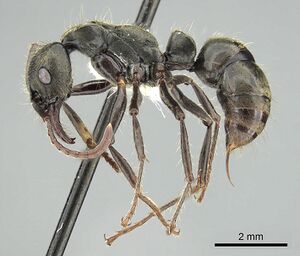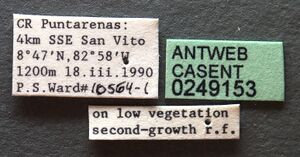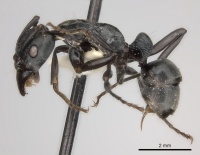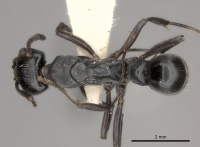Neoponera lineaticeps
| Neoponera lineaticeps | |
|---|---|

| |
| Scientific classification | |
| Kingdom: | Animalia |
| Phylum: | Arthropoda |
| Class: | Insecta |
| Order: | Hymenoptera |
| Family: | Formicidae |
| Subfamily: | Ponerinae |
| Tribe: | Ponerini |
| Genus: | Neoponera |
| Species: | N. lineaticeps |
| Binomial name | |
| Neoponera lineaticeps (Mayr, 1866) | |
From Mackay and Mackay (2010): This species nests in Tillandsia sp. [Bromeliaceae] in Costa Rica. Workers have been collected on the forest floor, as well as a male in Nicaragua (July). A worker (National Museum of Natural History) was intercepted on banana debris from Nicaragua.
Identification
From Mackay and Mackay (2010): The sculpture of the head of the worker and female would separate N. lineaticeps from most of the other species in the genus. Others with striae on the dorsum of the head include the Colombian Pachycondyla fuscoatra and the Brasilian Neoponera magnifica.
Neoponera lineaticeps can be distinguished from P. fuscoatra as the striae are mostly confined to the central region of the dorsum of the head and do not extend past the eyes on the side of the head, as they do in P. fuscoatra. The dorsum of the pronotum of N. lineaticeps is punctate, not coarsely striate as in N. magnifica. The entire funiculus of N. lineaticeps is brown, which would separate N. lineaticeps from Neoponera apicalis and Neoponera cooki. The well-marked posterior lateral margins of petiole would distinguish N. lineaticeps from the Costa Rican Neoponera dismarginata. The vertical striae or rugae (often poorly developed) on the posterior face of the petiole separate N. lineaticeps from Neoponera foetida (in which the striae are horizontal) and from Neoponera theresiae, Neoponera villosa and Neoponera bugabensis, which lack striae or rugae on the posterior face. The smaller size and the sculpture of the head would separate N. lineaticeps from the common N. villosa.
The striae on the dorsum of the head of N. lineaticeps could cause confusion with the southern South American Pachycondyla striata. The distributions of the taxa are separated, which will reduce the possibility of confusing the two species. Pachycondyla striata is much larger with a total length of about 12 mm. The entire dorsum of the head is covered with fine striae in P. striata, not just the middle portion covered with coarse striae with the surrounding sculpture being total different (punctate), as it is in N. lineaticeps. Finally the dorsum of the pronotum is not covered with striae in N. lineaticeps, as it is in P. striata.
Neoponera lineaticeps is similar to Neoponera solisi, but can be easily separated as the posterior face of the petiole is rugulose, not smooth and glossy as in N. solisi.
Keys including this Species
Distribution
MEXICO, NICARAGUA, COSTA RICA, PANAMA (Mackay and Mackay 2010)
Latitudinal Distribution Pattern
Latitudinal Range: 21.4971833° to 8.89147°.
| North Temperate |
North Subtropical |
Tropical | South Subtropical |
South Temperate |
- Source: AntMaps
Distribution based on Regional Taxon Lists
Neotropical Region: Costa Rica, Honduras, Mexico (type locality), Panama.
Distribution based on AntMaps
Distribution based on AntWeb specimens
Check data from AntWeb
Countries Occupied
| Number of countries occupied by this species based on AntWiki Regional Taxon Lists. In general, fewer countries occupied indicates a narrower range, while more countries indicates a more widespread species. |

|
Estimated Abundance
| Relative abundance based on number of AntMaps records per species (this species within the purple bar). Fewer records (to the left) indicates a less abundant/encountered species while more records (to the right) indicates more abundant/encountered species. |

|
Habitat
Neoponera lineaticeps has been collected in tropical rain forest and cloud forest, as well as canopy forest, from 50 – 1300 meters elevation. (Mackay and Mackay 2010)
Biology
Castes
Worker
Images from AntWeb
   
| |
| Worker. Specimen code casent0249153. Photographer Ryan Perry, uploaded by California Academy of Sciences. | Owned by PSWC, Philip S. Ward Collection. |
Nomenclature
The following information is derived from Barry Bolton's Online Catalogue of the Ants of the World.
- lineaticeps. Pachycondyla lineaticeps Mayr, 1866a: 502 (w.) MEXICO (no state data).
- Type-material: lectotype worker (by designation of Mackay & Mackay, 2010: 437), 2 paralectotype workers, 1 paralectotype queen.
- [Note: no queen is mentioned in the original description.]
- Type-locality: lectotype Mexico: (no further data); paralectotypes with same data.
- Type-depository: NHMW.
- Mackay & Mackay, 2010: 438 (q.m.).
- Combination in Neoponera: Emery, 1901a: 47;
- combination in Pachycondyla: Brown, in Bolton, 1995b: 306;
- combination in Neoponera: Schmidt, C.A. & Shattuck, 2014: 151.
- Status as species: Emery, 1890a: 73 (in key); Emery, 1890b: 42; Dalla Torre, 1893: 34; Emery, 1894k: 48; Forel, 1899c: 13; Emery, 1911d: 72; Wheeler, W.M. 1934g: 160; Brown, 1957e: 230; Kempf, 1972a: 162; Bolton, 1995b: 306; Mackay & Mackay, 2010: 437 (redescription); Branstetter & Sáenz, 2012: 263; Fernandes, et al. 2014:134 (in key).
- Distribution: Costa Rica, Mexico, Nicaragua, Panama.
Unless otherwise noted the text for the remainder of this section is reported from the publication that includes the original description.
Description
Worker
From Mackay and Mackay (2010): This is a moderately large (total length 10 mm) black species with brown mandibles and antennae and reddish brown legs. The eye is relatively large (maximum diameter about 0.5 mm) located about one maximum diameter from the anterior margin of the head (side view). The malar carina is sharp and well developed. The pronotal shoulder is developed into a sharp carina, which overhangs the side of the pronotum, the metanotal suture is depressed on the dorsum of the mesosoma, where it breaks the sculpture. The posterior lateral edges of the propodeum form a carina, as does the posterior lateral edges of petiole. The anterior face of the petiole is vertical, the posterior face is broadly rounded and meets the anterior face of the node.
Most surfaces are covered with erect hairs, including the dorsum of the head, the ventral surface of the head, the scapes, the dorsum and sides of the mesosoma, the legs (the hairs on the tibiae are mostly suberect), the petiole and all surfaces of the gaster. Appressed pubescence is also abundant and dense on the dorsum of the head, the dorsum of the mesosoma, the side of the mesosoma, the petiole and the dorsum of the gaster.
Much of the dorsal surface of the head is covered with punctures, some of which are in rows and form striae. The head is slightly swollen on the vertex, with that area covered with coarse longitudinal striae that diverge posteriorly, which is the characteristic that defines this species. The striae cover only the central part of the dorsum of the head, the sides and the parts anterior and posterior to the eye are finely punctate. The dorsum of the mesosoma is finely punctate but the sculpture is covered with golden pubescence that hides much of sculpture. The side of the pronotum is punctate but moderately shining, the entire mesopleuron is punctate but moderately shining. The side of the propodeum is covered with coarse longitudinal rugae. The anterior face and side of the petiole are punctate and moderately shining, the posterior face of the petiole is punctate and moderately shining, usually with vertical rugae in the central region. The side of the petiole is striate in a specimen from Querétaro, México. The gaster is punctate and moderately shining.
Queen
From Mackay and Mackay (2010): The female (undescribed paralectotype) is a medium sized specimen (total length 11 mm) black ant with reddish brown appendages. The mandibles have approximately 12 teeth, the anterior margin of the clypeus is convex. The malar carina is well developed and the eye is large (maximum diameter 0.59 mm) and the scape extends to the posterior lateral corner of the head. The pronotal shoulder is formed into a sharp carina, which overhangs the side of the pronotum. The propodeal spiracle is oval-shaped. The petiole is shaped like that of the worker with a straight vertical anterior face and a broadly rounded posterior face, which meets the anterior face near the anterior edge. The anterior face of the postpetiole is vertical, but broadly rounded into the dorsal face.
Long (up to 0.6 mm in length) erect hairs are present on the mandibles, clypeus, dorsal surface of the head, mesosoma, petiole and gaster, as well as on the legs.
The dorsum of the head has abundant coarse striae, which are restricted to the central part of the head, with the region around the eye being finely punctate. The remainder of the ant is dull and finely punctate.
Male
From Mackay and Mackay (2010): The male (undescribed) is a moderate sized (total length 9 mm) yellowish brown specimen. The anterior margin of the clypeus is nearly straight. The clypeus is swollen medially and the anterior medial process forms a tiny bump. The head is 1.2 mm long and 1.08 mm wide (posterior to the eyes). The ocelli are large (maximum diameter of the medial ocellus 0.25 mm) located less than one diameter from the lateral ocellus. The pronotal shoulder is slightly swollen but does not form a carina. The node of the petiole is rounded dorsally and relatively thickened; the subpetiolar process forms a ventrally directed lobe.
Erect hairs are sparse on most surfaces, most less than 0.3 mm in length, present on the mandibles, clypeus, dorsal and ventral surfaces of the head, posterior border of the head, mesosoma, petiole, gaster and legs.
Most surfaces of the male are coriaceous and feebly to moderately shining.
Type Material
México. Lectotype worker, 2 paralectotype workers and 1 paralectotype female, here designated, Naturhistorisches Museum Wien, Vienna (Mackay and Mackay 2010)
Etymology
The name of this species is based on two words from Latin, linea, meaning line and caput, meaning head, referring to the striae on the dorsum of the head. (Mackay and Mackay 2010)
References
- Mackay, W.P., Mackay, E.E. 2010. The systematics and biology of the New World ants of the genus Pachycondyla (Hymenoptera: Formicidae). Edwin Mellon Press, Lewiston.
- Brown, W. L., Jr. 1995a. [Untitled. Taxonomic changes in Pachycondyla attributed to Brown.] Pp. 302-311 in: Bolton, B. A new general catalogue of the ants of the world. Cambridge, Mass.: Harvard University Press, 504 pp. (page 306, Combination in Pachycondyla)
- Emery, C. 1901b. Notes sur les sous-familles des Dorylines et Ponérines (Famille des Formicides). Ann. Soc. Entomol. Belg. 45: 32-54 (page 47, Combination in Neoponera)
- Mayr, G. 1866a. Myrmecologische Beiträge. Sitzungsber. Kais. Akad. Wiss. Wien Math.-Naturwiss. Cl. Abt. I 53: 484-517 (page 502, worker described)
- Schmidt, C.A. & Shattuck, S.O. 2014. The higher classification of the ant subfamily Ponerinae (Hymenoptera: Formicidae), with a review of ponerine ecology and behavior. Zootaxa 3817, 1–242 (doi:10.11646/zootaxa.3817.1.1).
- Troya, A., Marcineiro, F., Lattke, J.E. & Longino, J. 2022. Igaponera curiosa, a new ponerine genus (Hymenoptera: Formicidae) from the Amazon. European Journal of Taxonomy 823: 82–101 (doi:10.5852/ejt.2022.823.1817).
References based on Global Ant Biodiversity Informatics
- Dattilo W. et al. 2019. MEXICO ANTS: incidence and abundance along the Nearctic-Neotropical interface. Ecology https://doi.org/10.1002/ecy.2944
- Fernandes I. O., M. L. de Oliveira, and J. H. C. Delabie. 2014. Description of two new sepcies in the Neotropical Pachycondyla foetida complex (Hymenoptera: Formicidae: Ponerinae) and taxonomic notes on the genus. Myrmecological News 19: 133-163.
- Fernandes, P.R. XXXX. Los hormigas del suelo en Mexico: Diversidad, distribucion e importancia (Hymenoptera: Formicidae).
- Fernández, F. and S. Sendoya. 2004. Lista de las hormigas neotropicales. Biota Colombiana Volume 5, Number 1.
- INBio Collection (via Gbif)
- Kempf, W.W. 1972. Catalago abreviado das formigas da regiao Neotropical (Hym. Formicidae) Studia Entomologica 15(1-4).
- Longino J. T. 2013. Ants of Nicargua. Consulted on 18 Jan 2013. https://sites.google.com/site/longinollama/reports/ants-of-nicaragua
- Longino J. T. L., and M. G. Branstetter. 2018. The truncated bell: an enigmatic but pervasive elevational diversity pattern in Middle American ants. Ecography 41: 1-12.
- Longino J. et al. ADMAC project. Accessed on March 24th 2017 at https://sites.google.com/site/admacsite/
- Mackay, W.P. and E.E. MacKay. 2010. The systematics and biology of the New World ants of the genus Pachycondyla (Hymenoptera: Formicidae). Edwin Mellen Press Lewiston, NY
- Smith M. A., W. Hallwachs, D. H. Janzen. 2014. Diversity and phylogenetic community structure of ants along a Costa Rican elevational gradient. Ecography 37(8): 720-731.
- Vásquez-Bolaños M. 2011. Lista de especies de hormigas (Hymenoptera: Formicidae) para México. Dugesiana 18: 95-133
- Wheeler W. M. 1934. Neotropical ants collected by Dr. Elisabeth Skwarra and others. Bulletin of the Museum of Comparative Zoology 77: 157-240.

